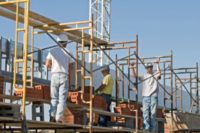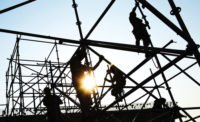During a 45-year career, there is a one in 200 chance that a construction worker will die from a work-related incident. That’s a pretty scary statistic.
In addition, one in every 10 construction personnel is injured annually, according to OSHA,1 making the non-fatal injury rate a massive 71 percent higher than any other industry.
It’s no surprise then that the trade remains one of the most dangerous occupations in the US, with hazards including falling from rooftops, unguarded machinery, being struck by heavy equipment, electrocution, silica dust, and asbestos, to name a few.
So why are so many people being killed at work despite stricter laws and increased safety measures? Let’s look at where the deaths and injuries are hitting most.
The “fatal four”
According to OSHA, the leading causes of private sector worker fatalities in the construction industry are:
- Falls
- Being struck by an object
- Electrocution
- Being caught in something/between two objects.
These four hazards are responsible for 60 percent of construction worker deaths. In fact, of all industries, construction sees the most fatal falls, accounting for 51 percent of all falls in the US.
In addition:
- Companies with ten or fewer employees and those who are self-employed account for nearly half of all deaths on construction sites.
- Workers who are between the ages of 25 and 34 are the most likely to be injured.
- Lifting, using a tool or machine, and carrying heavy objects are the leading causes of injury.
- Also of concern: about half of serious workplace injuries go unreported each year, meaning the scale of accidents is much higher.
Noise
Let’s not forget the unseen injuries too. Thirty million2 construction workers are exposed to prolonged hazardous noise on a regular basis, and 14 percent3 of them have hearing difficulty because of this. Any sound at 85 decibels or higher can cause ear damage. Machine operators are at high risk because the equipment they use regularly, like forklifts and bulldozers, is well above the 85 dBA level.
Although 51 percent4 of construction workers are exposed to hazardous noise, 31 percent report not wearing any hearing protection.
Big equipment
Safety with machinery is a major concern on most building sites. Scissor lifts are one of the most popular pieces of equipment used for construction and maintenance jobs that need to be done off ground.
A yearlong study by OSHA discovered that ten preventable deaths and 20 injuries with scissor lifts were the result of either bad fall protection or vehicle positioning and stabilization. Site managers simply ensuring crews follow basic rules and regulations could save many lives.
A forklift truck is another powerful and popular vehicle on job sites with many accidents reported including overturns, employees being struck, and falls from the vehicle. In addition to standard forklift training, crew members should also familiarize themselves with common forklift dangers such as attachment hazards, fueling safety, blind spots and ground conditions.
The cost
Of course, there is always a cost element with any type of breach in safety. The construction industry has a 71 percent higher spend on workers’ compensation than all goods-producing businesses combined. That’s more than twice the mean cost for the average employer in all other professions.
A company must sell an additional $1,667,000 in services to offset $50,000 in losses from injuries, illness or damage and still make a 3 percent profit.
Site injuries account for six to nine percent of project costs, while safety and health programs only account for 2.5 percent of project costs. So could the solution be more investment?
Action needed
As you can see from the statistics above, the construction industry has a long way to go to improve its health and safety record. Eliminating the “fatal four” causes of construction accidents alone would save 582 workers’ lives in the U.S. each year.
According to the National Safety Council, construction companies can save an average of $32,000 for each medically-consulted injury they avoid. Businesses can also save $8 for every dollar spent on a quality health and safety program.
It can be just simple measures and ensuring proper safety and health training is in place, as well as regular inspections and updated equipment that can mitigate some of the risks.
Cost savings to the company are secondary to the obvious benefits of keeping workers safe. A safe workplace can also result in indirect benefits like a positive company reputation, the ability to recruit the best talent and improved employee morale.
It is important that every construction crew member, even seasoned veterans, the self-employed and small contractors with just a few staff attend training and regular safety meetings. While larger construction companies may have specialist safety directors or advisors on their team, small businesses can take advantage of crucial free advice and resources from OSHA.5
In addition, another way for companies to promote safety is to take part in Construction Safety Week6 which runs annually, (this year May 4-8) with an aim to identify, reduce, and eliminate construction-related hazards. It includes mass safety meetings and equipment demonstrations, and supports companies to bring Safety Week to life by planning events on their own projects/sites and at their corporate offices. Tools and resources can be downloaded to help plan activities, including tips, best practices and Safety Week-branded materials to support events and communication.
The bottom line is that construction companies can’t afford to lapse on protecting workers, so putting safety first is the bottom line.
References





